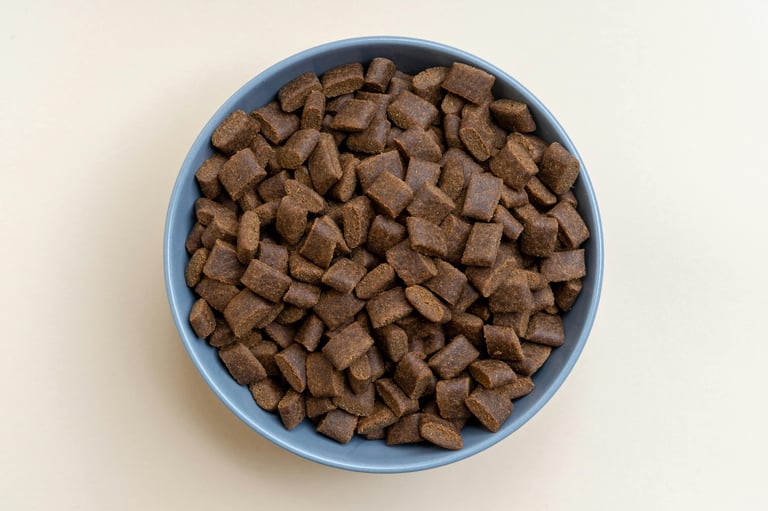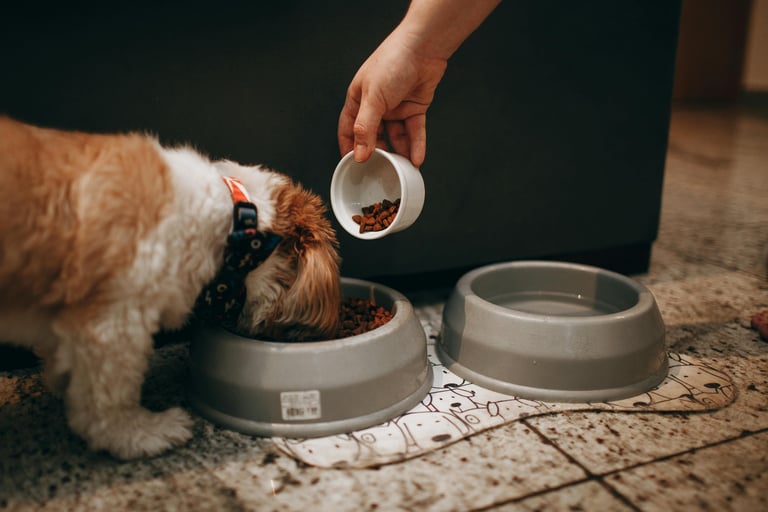Why You Should Avoid Corn in Your Dog’s Food
Health Risks and Better Alternatives
DOG NUTRITION TIPS
9/28/20254 min read


Why You Should Avoid Corn in Your Dog’s Food
At Bowl of Love, we sometimes recommend trusted products. If you choose to purchase through our links, we may earn a small commission at no additional cost to you. Thank you for supporting our mission to bring healthier food choices to dogs everywhere.
Why You Should Avoid Corn in Your Dog's Food: Health Risks and Better Alternatives
Many dog owners unknowingly feed their pets food containing corn, not realizing this common ingredient can cause significant health issues. Corn serves as a cheap filler in commercial dog foods but offers minimal nutritional value and can trigger digestive problems, allergies, and blood sugar spikes in dogs.
Corn appears in various forms throughout dog food ingredient lists, from whole kernel corn to corn gluten meal and corn syrup. Dogs struggle to properly digest corn due to their carnivorous digestive systems, which evolved to process meat rather than grains.
Understanding why corn creates problems for dogs helps pet owners make better food choices for their companions. Better alternatives exist that provide superior nutrition without the associated health risks that corn presents.
Why Corn Is Problematic in Dog Food
Corn presents several significant issues when used as a primary ingredient in commercial dog foods. The grain lacks essential amino acids, can trigger allergic reactions, and creates digestive challenges for many dogs.
Nutritional Shortcomings of Corn
Corn contains an incomplete amino acid profile that fails to meet dogs' nutritional requirements. Dogs need all ten essential amino acids, but corn is deficient in lysine and tryptophan.
The protein quality in corn ranks lower than meat-based proteins. Biological value measures how well a protein supports growth and maintenance. Corn scores approximately 60, while chicken meal scores 80-85.
Corn provides mainly carbohydrates rather than the protein and fat that dogs require. Wild canids consume less than 5% carbohydrates, yet corn-based kibble often contains 40-60% carbohydrates.
The high glycemic index of corn causes rapid blood sugar spikes. This can contribute to obesity and diabetes in susceptible dogs.
For a corn-free, healthy option, we recommend JustFoodForDogs.
Potential Allergic Reactions
Food allergies affect approximately 10% of dogs, with corn ranking among the top allergens. Corn gluten protein triggers immune responses in sensitive animals.
Symptoms of corn allergies include chronic ear infections, skin irritation, and digestive upset. Atopic dermatitis commonly develops in dogs consuming corn-based diets over extended periods.
Cross-contamination during processing introduces additional allergens. Corn facilities often process wheat, soy, and other common allergens on shared equipment.
Even dogs without diagnosed allergies may experience inflammatory responses to corn proteins. These reactions manifest as poor coat condition, excessive shedding, and persistent scratching.
Digestibility Issues for Dogs
Dogs lack sufficient amylase enzymes to break down large amounts of starch effectively. Their pancreas produces limited amounts compared to omnivorous animals.
Undigested corn appears in stool, indicating incomplete nutrient absorption. This creates larger, more frequent bowel movements and potential gastrointestinal discomfort.
Resistant starch in corn passes through the small intestine unchanged. Bacterial fermentation in the colon produces gas and loose stools in many dogs.
Processing methods like extrusion improve digestibility slightly but cannot overcome dogs' fundamental inability to efficiently process high-starch foods. Heat treatment destroys some nutrients while creating harder-to-digest compounds.
Healthier Alternatives and Choosing the Right Dog Food
Pet owners can select better nutrition options by understanding grain-free formulations, interpreting ingredient labels correctly, and identifying quality protein sources that support canine health.
Benefits of Grain-Free Options
Grain-free dog foods eliminate corn, wheat, and soy while focusing on meat-based nutrition. These formulations typically contain higher protein percentages and fewer carbohydrate fillers.
Dogs with sensitive stomachs often experience improved digestion when switched to grain-free options. The absence of corn reduces potential allergen exposure for dogs with specific grain sensitivities.
Key grain-free ingredients include:
Sweet potatoes or peas as carbohydrate sources
Multiple animal proteins as primary ingredients
Vegetables like carrots, spinach, and blueberries
Natural fats from fish oil or chicken fat
Many grain-free formulas provide better nutrient density per serving. Dogs may require smaller portions to meet their nutritional needs compared to corn-based alternatives.
How to Read Dog Food Labels
The ingredient list appears in descending order by weight before processing. The first five ingredients typically comprise 80% of the food's content.
Ingredients to prioritize:
Named meat sources (chicken, beef, salmon)
Meat meals (chicken meal, fish meal)
Whole vegetables and fruits
Natural preservatives like vitamin E
Red flag ingredients include:
Corn gluten meal
Corn syrup
By-product meals from unspecified sources
Artificial colors and flavors
The guaranteed analysis shows minimum protein and fat percentages plus maximum fiber and moisture content. Premium foods often exceed these minimum requirements significantly.
For a clean list of ingredients for you dog, we recommend Instinct Raw Boost.
Selecting Appropriate Protein Sources
Dogs require complete amino acid profiles found in animal proteins. Single-source proteins work best for dogs with food allergies or sensitivities.
High-quality protein options:
Fresh meats: Chicken, turkey, beef, lamb
Fish: Salmon, herring, whitefish
Meat meals: Concentrated protein with moisture removed
Novel proteins: Duck, venison, rabbit for sensitive dogs
Protein should comprise 25-30% of adult dog food and 28-35% for puppies. Active dogs and working breeds benefit from higher protein percentages.
Rotate protein sources gradually to prevent food sensitivities from developing. Introduce new proteins over 7-10 days by mixing with current food in increasing proportions.




Connect
Reach out for support and inquiries.
Subscribe
contactbowloflove@gmail.com
© 2025. All rights reserved.
